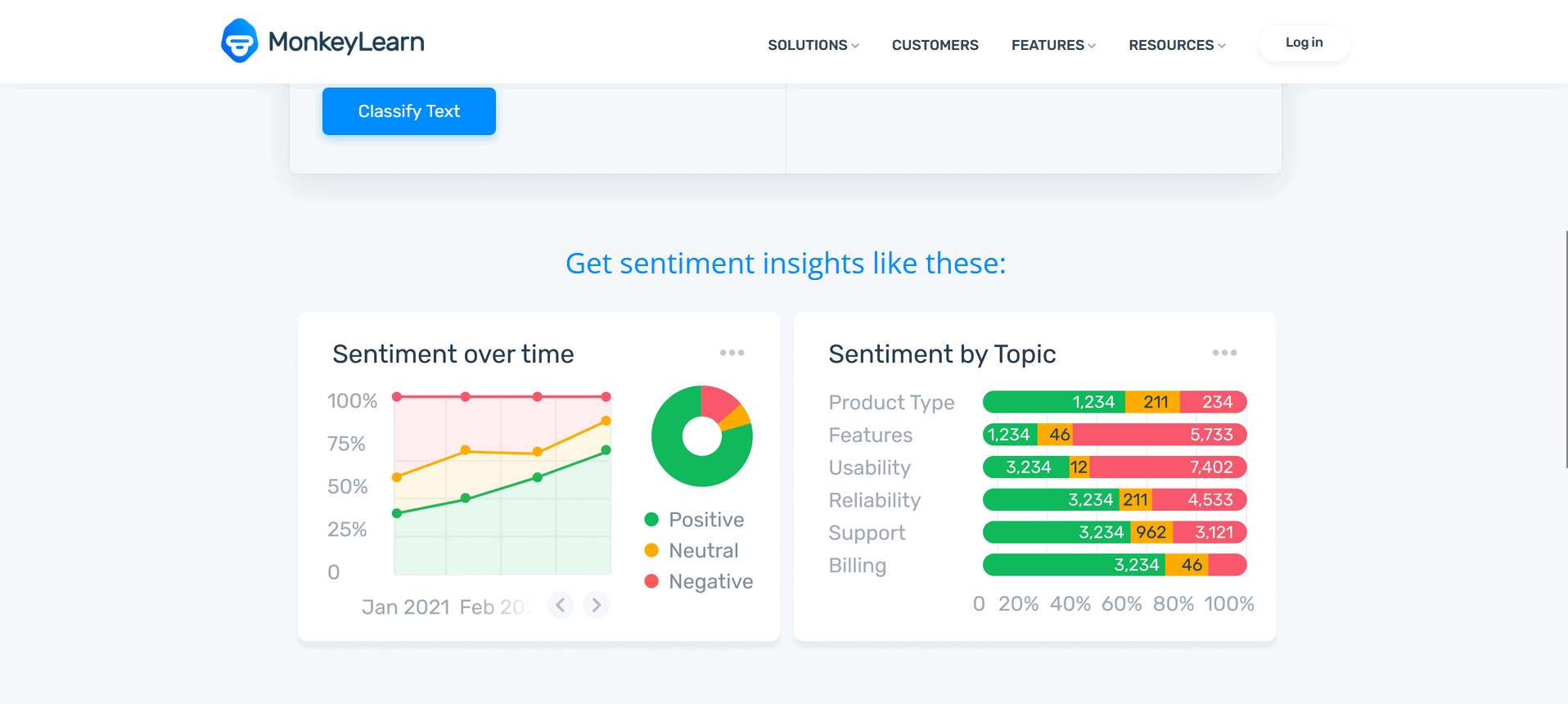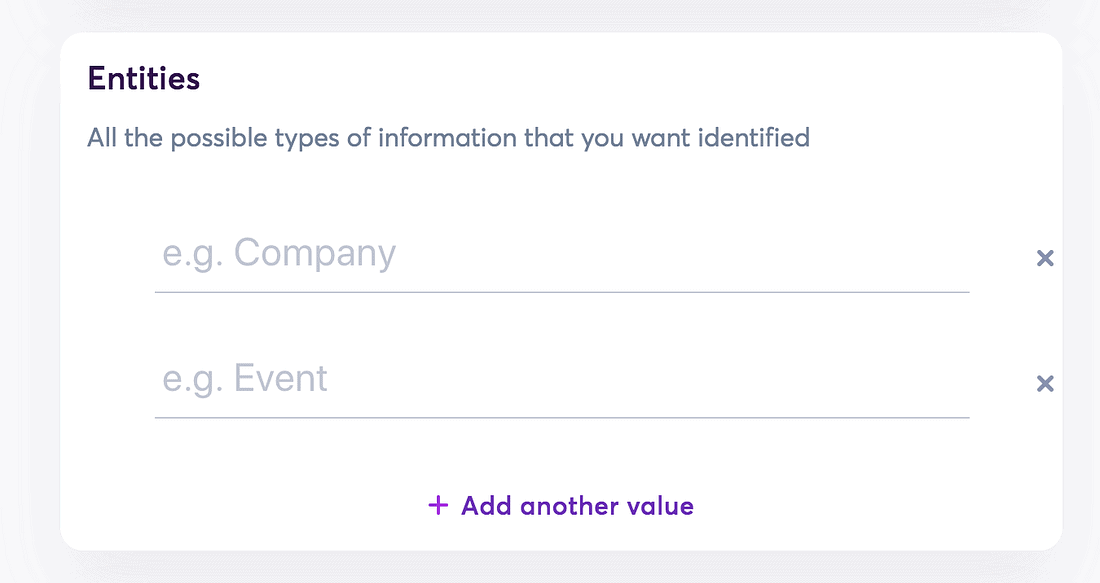We all know that how your customers feel about your company is a vital part of your success. In the world of social media, getting to know more about customer sentiment is easier than ever – mentions on social media sites, alongside online reviews and surveys, are a great way to learn about how you’re being viewed by your customers.
However, that also brings a vast increase in data that is simply impossible to collect and analyze on your own. Imagine how difficult it would be to accurately gauge customer sentiment from literally thousands of different online reviews, social media posts, and survey responses.
Fortunately, the days of going through each piece of data individually are well behind us. With AI-powered sentiment analysis, this whole process can be automated: it will produce intelligent and accurate reports about customer sentiment, collected from a range of relevant data sources, and you’ll be able to tweak and refine those parts of your business that aren’t resonating with customers.
In today’s business world, it’s crucial that you increase the role of AI in any social media marketing strategy: AI-driven sentiment analysis uses both social media as a source of data and will change your social media campaigns for the better going forward.
Read on to find out how AI-powered sentiment works and how you can implement it in your organization.
What is AI-Powered Sentiment Analysis?
You’ve probably heard a lot about AI over the last couple of years. Artificial intelligence is becoming an increasingly important part of all of our lives, whether that’s through AI-content generators like ChatGPT, machine learning data analysis, or helping programmers to design apps such as a remote desktop management tool.
AI-driven sentiment analysis – also known as opinion mining – simply uses the technology behind all of these initiatives and applies it to customer sentiment research. By setting up algorithms to analyze language and text, AI-powered sentiment analysis can determine the feelings that lay behind a statement or post, assessing how positive, negative, or neutral it is.
Here is an example of what sentiment analysis looks like in practice:

Screenshot taken from monkeylearn.com
AI-powered sentiment analysis should be thought of as a way of extracting the most valuable information from a huge range of data sources. Rather than relying on human workers to slowly comb through an insurmountable heap of tweets, social media posts, and reviews, it uses the advanced algorithms of AI to quickly and accurately work out your customers’ emotions.
How does AI-Powered Sentiment Analysis Work?
So, that’s the basics of AI-powered sentiment analysis. But if you want to truly appreciate the role of AI in modern social media marketing, it’s important that you know a little about how it works. This will mean that you can better apply it in your own organization.
The main bit of technology behind opinion mining is called natural language processing. This subfield of AI allows computers to interpret language, whether that’s through written or verbal communication.
Natural language processing will then let a computer program extract meaning from a bit of text, just like how we can infer that a friend is angry, happy, or sad from the ways in which they write a message to us. This technology is then combined with access to data to produce sentiment analysis.
One common example of AI-powered sentiment analysis is the Named Entity Recognition Model. In this, the AI algorithm is given a set of phrases – such as the name of your company or product – and regularly tracks through data sources like social media platforms.
When these named entities are referenced in social media posts or online reviews, the algorithm will recognize this and create an alert or notification. This can be a useful tool for sentiment analysis on its own, as a sudden upsurge in mentions online is usually an indicator of strong emotions.
If you’re using a tool relying on a Named Entity Recognition, your inputs will look something like this:

Screenshot taken from super.ai
However, you can then use AI-driven technology to analyze sentiment in more detail – after all, a company setting up a Named Entity Recognition tool that notifies them every time their remote desktop app for Android is mentioned on Twitter won’t be able to know whether those mentions reflect positive or negative sentiments about the app from their customers.
This is where you can use one of two different approaches to develop a more sophisticated approach to AI-powered sentiment analysis. Firstly, rule-based sentiment analysis assigns a numerical value to certain words or phrases that are used in reviews and posts according to their positivity.
You’ll then set up a series of additional rules to work around some of the common issues that arise with this approach – for instance, making sure that “no good” isn’t assigned a positive value just because it has “good” in it.
This rule-based approach is a simple and straightforward way to establish AI-powered customer sentiment analysis, as it gives you an easy understanding of customer feelings. However, it’s a pretty broad tool that isn’t able to deal with things such as sarcasm.
This means that a second approach is becoming more and more popular: machine learning sentiment analysis. Machine learning is a more advanced form of AI, as it has the capability to learn for itself and develop over time.
Machine learning sentiment analysis is what most people now think of when they think about AI-powered sentiment analysis. It uses a trained machine learning model deployment to analyze your data, drawing from both predetermined rules and a more intelligent approach to analysis that can deal with the complexity that naturally comes with language.
Benefits of AI-Powered Sentiment

Free to use image from Unsplash
Now that you know a bit more about how AI-powered sentiment analysis works, why should you find a way to implement it into your social media strategy? Well, here are the biggest benefits of increasing the role of AI-driven sentiment analysis:
Automated and speedy analysis
There’s no doubt that the most important benefit of AI-powered opinion mining is that it automates a previously arduous manual task. This frees up time and resources for you to spend on more difficult, creative, and demanding jobs, such as using the insights provided by sentiment analysis to craft better social media marketing materials.
Because this process is fully automated, it provides rapid analysis. This means that you can respond quickly to any sudden rise in negative customer sentiment, allowing you to essentially use it as an early warning system with regard to poor customer experience.
Leverage huge amounts of data
Whether it’s through setting up customer activity tracking or migrating legacy applications to the cloud, you probably have access to an overwhelming range of data. However, many organizations aren’t able to make the most out of all of that information.
With AI-driven automated sentiment analysis, you’ll be sure to leverage more of your data constructively, using sources from across the internet to provide insights that you would otherwise overlook. Only by using as much data as possible will you be able to get a proper understanding of how your customers are feeling.
Optimize customer experience
Of course, all of that data won’t mean anything if you don’t do anything with it. One of the biggest benefits of AI-driven opinion mining is how you can use its insights to improve customer experience, which is one of the most important aspects of any customer-facing business.

Free to use image from Unsplash
Let’s say that your analysis finds that negative emotions are linked to a specific element of your website, such as your customer service portal. Because you know that this is a weak part of your customer experience, you’ll be able to invest time and resources into improving it while knowing that your investment will pay off.
Know your audience
The customers are always the most important of any business’s success. It’s crucial that you know your audience inside out in order to build your organization around their interests and needs – and AI-powered sentiment analysis will give you better insights than ever into your customer base.
By analyzing posts from across the internet, opinion mining will let you have a deeper understanding of your customers than simply using demographic or sales data. You’ll know what makes them tick and which parts of your business elicit the strongest emotions from them.
With this information, you’ll be able to improve customer loyalty and build a stronger-than-ever relationship between you and your customer base.
Produce data-driven decisions
Everyone knows that the best business decisions are made with as much information as possible. Without this approach, your decisions will be driven by hunches rather than hard data – risking your organization’s future and ensuring that some of your efforts and investments will be wasted.
With opinion mining, you’ll be able to make decisions about customer experience and social media marketing with clear data about your customers’ feelings and opinions, so you can be confident that you’re making the right decisions.
To get the most out of AI-powered sentiment analysis, you should use it alongside other data sources to make as many decisions as possible data-driven. You might want to use Vonage call tracking, for instance, to extract data from marketing and customer service calls, while you’d also want to collect detailed information about your sales numbers.
The Role of AI Powered Sentiment Analysis in Social Media Marketing

Free to use image from Unsplash
As we’ve highlighted, AI-driven sentiment analysis is a powerful tool in today’s world of business, where brand reputations live and die according to social media and online reviews. As generative AI in banking evolves, it has the potential to transform data-driven strategies, offering innovative ways to enhance customer experience and operational efficiency. To help you figure out how to use it in your organization, here are some examples of how AI-powered opinion mining is used in different industries.
AI-powered sentiment analysis in software-as-a-service
Software-as-a-service (SaaS) is heavily dependent on online reputation – after all, all it takes to put off potential customers is a few negative posts about your brand to appear in a Google search when they’re looking for your website.
A company that wants to know how their software is being received could set up a search for posts including their brand name and a basic function of their software – such as remote access to computer – in order to work out whether customers are able to use their services effectively.
Any issues that come out of this analysis can then be quickly rectified through a software update, while the company would also adapt their social media marketing to counter any negative posts.
AI-powered sentiment analysis in online services
Similarly, businesses providing online services – whether that’s virtual banking or providing security for online courses – need to be aware of how negative reviews and social media posts impact their ability to collect new customers. That’s because we’re all easily influenced by other people’s opinions of a brand or company, especially when we see those opinions on social media.
AI-powered opinion mining would let an online services company easily see what’s working and what isn’t. A creative way that they might want to use these insights would be to include statistics about positive responses in their social media marketing materials to generate social proof about the service.
AI-powered sentiment analysis in retail

Free to use image from Unsplash
A great way for retailers to use AI-driven sentiment analysis would be to find trends in their customer base that will let them shape their future strategies. A retailer could identify markets where existing sentiment towards a sector was largely negative and choose to target that demographic with heightened social media marketing, for instance.
Additionally, by conducting online surveys using an online survey maker alongside sentiment analysis, businesses can gain more in-depth insights into customer preferences and opinions, allowing for a more comprehensive understanding of their target audience.
Alternatively, new trends in retailing, like cashless shopping, can generate vocal negative reactions. However, using AI-driven sentiment analysis will let you get a genuinely representative image of your customers’ reactions to these sorts of trends, meaning that you won’t be swayed by a loud minority of customers.
AI-Powered Sentiment Analysis – The Future of Social Media Marketing
If you want your business to truly take into account the views and needs of your customers, AI-driven sentiment analysis is an invaluable tool. Without a simple way to find out the emotions behind social media posts and online reviews, your decisions will be driven by hunches rather than hard data.
That’s why the role of AI-powered sentiment analysis in your social media marketing strategy is so important. It should be used alongside your social media campaigns to create incoming data about the efficiency of those campaigns, while the data produced should influence your future social media marketing strategy.
With AI becoming increasingly popular across the business world, there’s no time like the present to start using it in your customer sentiment analysis!

